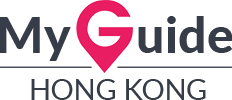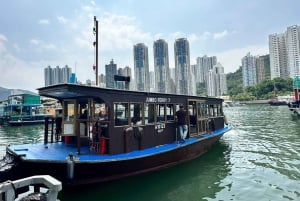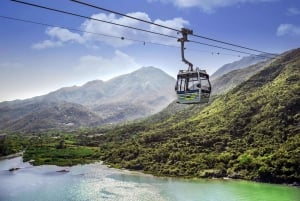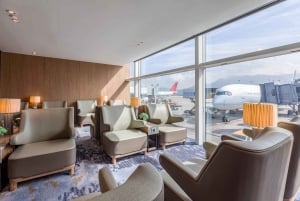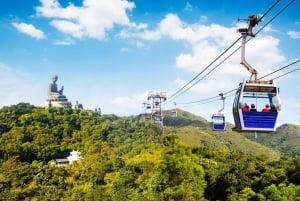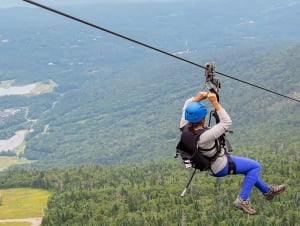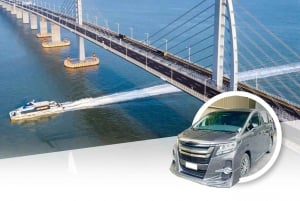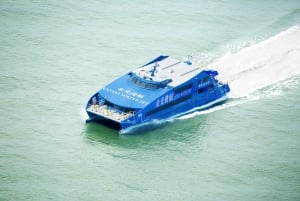Transportation Info
MTR Info
The Mass Transit Railway (MTR) system is one of the cleanest and most efficient underground systems in the world. It is consists of nine lines, namely Kwun Tong Line , Tsuen Wan Line , Island Line, Tung Chung Line, Tseung Kwan O Line, Disneyland Resort Line, East Rail Line, Ma On Shan Line, and West Rail Line; and has a total of 82 stations. Now also operated by the MTR, the Airport Express provides services between Central Hong Kong Island and Hong Kong International Airport, and has stops at Kowloon, and AsiaWorld Expo. The Light Rail network on the other hand can take you to 68 stops in the North West NewTerritories. In addition, it also provides fast train services to major cities across mainland China.
See below for the general destinations of each line:
| 1. Airport Express – between AsiaWorld-Expo (Lantau Island), Kowloon and Hong Kong island 2. Tsuen Wan Line – between Tsuen Wan (New Territories), Kowloon and Central, Hong Kong Island 3. Island Line – between Sheung Wan and Chai Wan (Northern Part of Hong Kong Island) 4. Kwun Tong Line – between Yau Ma Tei (Kowloon) and Tiu Kend Leng (Sai Kung) 5. Tung Chung Line – between Tung Chung (Lantau Island) and Hong Kong Island 6. Tseung Kwan O Line – between Po Lam and North Point, Hong Kong Island 7. Disneyland Resort Line – between Sunny Bay and DisneylandResort 8. East Rail Line – between Hung Hom (Kowloon) and Lo Wu and Lok Ma Chau (New Territories) 9. West Rail Line –between East Tsim Sha Tsui (Kowloon) and Tuen Mun (New Territories) |  |
There are also some interchange stations to allow passengers to switch trains or lines across the platform. Refer to the map to see the location of these interchange stations. Running time between one end to the other varies depending on which line you are at, but the average is around 25 minutes to 40 minutes. You need not to worry about not being familiar with the stations because announcements in English, Cantonese and Standard Mandarin Chinese are made when you arrive at a station.
Daily operating hours are from 05:30am- 1:00am the next day.
You can buy a single ticket that costs around HK$4 to HK$26, depending on the distance of your travel. There are also other types of tickets that are valid for more days, or have unlimited rides in one day. The Tourist Day pass costs HK$55 for adults and HK$25 for children. Usually, this is a good purchase for tourists and frequent users. Check the website of MTR to learn more about the different types of tickets and their rates.
You can also pay using an Octopus Card that you can purchase and reload at MTR counters. Just swipe the card along the electronic readers at the station barriers before departing at a station and again once you arrive at your destination.
Because the MTR has a high level of daily passenger traffic, the MTR stations are equipped with facilities offering all of the services you might need, such as hotel reservation agencies, convenience stores, fashion shops, pastry shops, Disneyland ticketing agency, Bill Payment Centers, ATM services, customer service centers, post boxes, souvenir shops, and even computer centers.
| Local Tip: During the rush hour, around 08:30-9:00am and 6:00-7:00pm, high volumes of students and workers flock the terminal, making the terminal and the trains crowded. |
Ferry Info
You will never experience the beauty of Victoria Harbour if you don’t ride a ferry that runs through it. You can opt to ride a ferry that goes to the outlying islands or one that just circles the harbour on a single daytime/nighttime roundtrip. Rates vary depending on the time and date you’re taking the tour. Moreover, cross-harbour ferry fares are cheaper compared to buses and the MTR.
The rates are as follows for the Harbour Tours that depart from Star Ferry Piers in Tsim Sha Tsui, Central, Wan Chai and Hung Hom. Please check their website to confirm the schedules on the dates of your travel.
| a) Single daytime roundtrip departing hourly between 2:05pm and 5:05pm daily: HK$70 for adults; HK$63 for children aged 3-12 y/o and seniors over 65. b) Half-day hopping pass departing from 11:05am-5:05pm: HK$95 for adults; HK$86 for children aged 3-12 y/o and seniors over 65. c) Full-day hopping pass departing from 11:05am-7:05pm: HKS200 for adults; HK$180 for children aged 3-12 y/o and seniors over 65. d) Single ride night roundtrip taken between 6:05pm and 11:05pm: HK$140 for adults; HK$126 for children aged 3-12 y/o and seniors over 65. e) 2-hour night roundtrip departing at 7:05pm and 9:05pm: HK$ 170 for adults; HK$153 for children aged 3-12 y/o and seniors over 65. |  |
Aside from having tours, ferries are alternative means of public transport to buses and railways. The Star Ferry serves Hong Kong and Kowloon. The ferries in the piers in Central go to Discovery Bay and Mui Wo on Lantau, Sok Kwu Wan and Yung Shue Wan on Lamma, Peng Chau, Cheung and Park Island (Outlying Islands).
If you are that traveler who would like to take the extra journey to explore the other Special Administrative Region of China, there are also 4 ferry terminals in Hong Kong where you can take a ferry ride to Macau: Macau Ferry Terminal (found at 202 Connaught Road, Central), China Ferry Terminal (found at 33 Caton Road, Kowloon Peninsula), Hong Kong International Airport and Tuen Mun Ferry Terminal (found at 148 Wu Chai Road, Tuen Mun.
| Local Tips: Ticket Sales at Star Ferry counters stop 10 minutes before each departure so it is best to schedule your tour and book early. There are no night sailings from Wanchai Ferry Pier. It is best to ride a ferry at night, at 7:05pm to see the spectacular Symphony of Lights multimedia show presented by 44 buildings on Hong Kong Island and Kowloon |
Taxi Info
Riding a taxi can be one of the most convenient ways to get around; you get to enjoy your personal space while travelling and eradicate the hassles of walking from one place to another to reach a train,bus or a tram.
| Taxis in Hong Kong are color-coded according to the territories they service. The red ones are urban taxis – those that go to Hong Kong Island and Kowloon. The green ones are in New Territories, while those on Lantau Island are blue. There are implemented taxi pick-up and drop-off points as well as taxi stands all over Hong Kong. Most of these are situated near hotels, tourist spots, MTR stations, ferry piers, and famous landmarks and restaurants. To know if a taxi is available for hire, look for the lit sign on the roof of a taxi. Others indicate that they are available for hire when a flag marked "FOR HIRE" is visible on top of their dashboard. You may also opt to make use of the Taxi Call Service offered by different taxi operators. A list of taxi operators and their numbers can be found on the Transport Department website. A 24-hour free hotline (187-2920) is also available to entertain lost property inquiries. Flagfall charges for the first 2 kilometers are from HK$15 to HK$20 with incremental charges that cost HK$1.0 to HK$1 per succeeding 200 meters. The incremental charges also depend on the taxi type and length of journey. Detailed taxi fare information is listed on the inside of the taxi. As expected, taxi fares are more costly than bus fares. |    |
All taxis operating in Hong Kong are running on LPG, as prescribed by the government, to reduce pollution in the streets.
You may contact the Transport Department (www.td.gov.hk) Hotline for further information -2804 2600.
| Local Tips: Some reminders to enjoy the ride: 1. Passengers are required to use seatbelts by law. 2. Always ask for a receipt from the taxi driver. 3. Please refer to taxi meter for exact charge. 4. Please pay taxi driver in local currency (HK$). You may contact Transport Department Hotline for further information -2804 2600. |
Bus Info
Like the MTR, buses in Hong Kong will bring you to almost all destinations. Should you need to know which route would bring you the fastest to your desired destination, a chart of bus routes are available for reference at bus stops along main avenues. About 570 bus routes are operated by 5 franchised bus companies, managing about 5,800 buses which are mostly air-conditioned and double-deckers. Buses are numbered to signify the route they follow and the places they reach. The chart posted in the bus stops show the corresponding numbers of the buses that load/unload in that specific stop.
The main depot on Hong Kong Island is under Exchange Square. On Kowloon, the hub is by the Star Ferry in Tsim Sha Tsui.
Operating hours of different bus services vary. Those who operate whole day, and observe a circular route run from 06:00am up to 12:00am the next day. Some buses run only during the morning, or what they call Morning Peak Hours, while some run only at night.
There are three major bus franchises that operate routes on Hong Kong Island, Kowloon and the New Territories. These are: (1) Kowloon Motor Bus; (2) New World First Bus; and (3) Citybus. In Lantau Island, the New Lantao Bus and Long Win Bus provide bus services. Some buses have routes passing the Cross Harbour Tunnel, the Eastern Harbour Crossing, and the Western Harbour Crossing to reach the destinations that are on the other side of the harbour. A Disneyland bus route is also available to accommodate the many locals and tourists heading for the theme park.
| Here is the list of the range of prices of tickets per route: Kowloon Routes – HK$ 3.5 to HK$12 West Kowloon and Tseung Kwan O (by the New World First Bus) – HK$3.7 to HK$ 14.8 New Territories Routes – HK$3.3 to HK$42 Cross-harbour tunnel Routes – HK$8.9 to HK$23 Eastern Harbour Crossing Routes – HK$9.4 to HK$34 Western Harbour Crossing Routes – HK$9 to HK$31 North Lantau Routes (by New Lantao Bus company) – HK$3 to HK$28 DisneylandRoutes – HK$7.0 to HK$38 |    |
Pay your fare upon entry by swiping your Octopus Card on the reader, or by dropping the exact amount of coins in the coin box both located next to the driver. Please be reminded that the average fares above are for adults. Children age 3-12 years old and seniors over 65 enjoy fare discounts at a minimum of HK$2.
MTR Feeder Bus
The MTR Corporation provides a total of 116 buses in Northwest and Northeast areas of the New Territories, going around on 13 bus routes. They serve as feeder buses to bring people to MTR West Rail Line, East Rail Line and Light Rail Stations. The fare costs HK$3.6.
Cross Border Routes
Aside from the regular bus routes which only take you around the regions of Hong Kong, buses having cross border routes can bring you to some parts in Mainland China. There are 4 road crossing points between Hong Kong and China. They are the following: Lok Ma Chau, Sha Tau Kok, Man Kam To and Shenzhen Bay Port. If you plan on taking this route, be ready with your valid travel documents because the destinations here are restricted. The standard bus fare is HK$12.
Minibuses
Also known as Public Light Buses, minibuses accommodate 16 passengers only and serve routes that are not serviced by the major public bus franchises. Riding a minibus is beneficial to those who’d like to reach the alleys farther from main roads, and for those who are impatient with long travel time. (Minibuses are faster because once it is filled with passengers, it doesn’t stop until someone asks to get off). To indicate to the driver that you want to alight, shout. It is advisable that you speak some Cantonese and that you are familiar with Hong Kong so that you won’t get lost when riding a minibus.
There are two kinds of minibuses:
1. Red-roofed – They do not have a fixed route, hence allowing passengers to get on and off at any point. Passengers need not to give exact amount as change is given by the driver. Hand over the fare upon disembarking the minibus.
2. Green-roofed – They have fixed routes and fixed fares. Hand over the fare when boarding the bus. Here, you need to pay the exact fare through coins or Octopus Card because the driver doesn’t give change.
Fares for minibuses are more expensive than those of regular buses. It ranges from HK$2 to HK$22.50.
GENERAL NOTE: Bus stops are evenly spread out across the regions. For full details of routes, schedules, and fares, check the websites of the bus operators.
| Local Tips: When riding major bus routes, use Octopus card or give exact fare as change is not given. For some bus routes, fares during Sundays and Public Holidays are higher. No smoking, drinking and eating inside the bus. Standing is allowed on the lower-deck of the bus only. Press the bell to indicate that you wish to be dropped at the next stop. Wi-Fi access is available in most routes operated by Citybus and New World First Bus. |
Tram Info
Nothing beats touring the old fashioned way. Trams have been running on Hong Kong Island since 1904. In 2010, there are currently 163 trams in operation with 230,000 passenger trips daily. The most popular among tourists and local sightseers is the cable-hauled funicular tramway that operates between Garden Road in Central and The Peak climbing 373 meters. This is called the Peak Tram.
| The Peak Tram runs from 07:00am until midnight with four stops along way. It takes only about 15 minutes to reach the Peak. Buy your tickets at Central and at The Victoria Peak station. A Single Peak Tram ticket costs HK$28 for adults and HK$11 for children aged 3-11 and seniors over 65. A Return Peak Tram ticket costs HK$40 for adults and HK$18 for children aged 3-11 and seniors over 65. There are other ticket packages, such as a package of a round-trip ride on the Peak Tram including a pass to the Sky Terrace 428. Kindly check their website for more information regarding ticket packages and other offers. Aside from the Peak Tram, there are also double-decker trams which travel along the Northern part of Hong Kong Island. It has an Eastbound Route and Westbound Route with departures per hour. It runs from early morning to midnight. Experience the Hong Kong Tram – locally known as the Ding Ding – for only HK$2.3 regardless of the distance travelled. (For children: HK$1.20; seniors over 65: HK$1.00). This is why trams are considered the cheapest mode of transport. |     |
Payment method for both trams is only through exact amount of cash or Octopus Card.
For further information regarding Hong Kong Tram routes and schedule, check out www.hktramways.com .
Cruise Info
Located in the heart of Tsim Sha Tsui is one of the world’s busiest terminals: the Ocean Terminal. It is Hong Kong’s main docking facility for more than 20 international cruise ships. In the same area are immense shopping malls with around 700 shops and 50 restaurants.
The Ocean Terminal is one of the hubs of Star Cruises. From here, cruise ships go to Vietnam, Mainland China and Taiwan.
| Harbour Cruise Bauhinia, which departs from North Point Ferry Pier at 7:30pm and from Hung Hom Ferry Pier at 8:00pm, offers a 2-hour nightly cruise with packages to die for. An international style buffet dinner keeps you full while you enjoy the live band that sets your mood for the night. Aboard, you can also enjoy a perfect view of the Symphony of Lights multimedia show. (Check their website to confirm rates and for reservation.) Aqua Luna Junk , on the other hand, is a cruise with a more distinct personality, as it is built using traditional shipbuilding methods. It is inspired by Cheung Po Tsai, a pirate. They have 8 sailings daily, each with a capacity of 80 passengers. Aqua Luna leaves from Public Pier 4 in Tsim Sha Tsui, Kowloon and from Central Pier 9, Hong Kong Island. Tickets include a free drink only but snacks and cocktails are available on board for purchase. (Check their website to confirm rates and for reservation.) |  |
Aside from the above-mentioned, several private companies and restaurants offer Dinner Cruise, Function Cruise, and Business Cruise at the harbour several times of the day.
Those who live in inland cities may appreciate a simpler nature cruise available in Tai O Village, located in Lantau Island. Here you can take a small boat that will tour you around Tai O village, which is famous for its stilt houses; but the tour doesn’t finish with that. The boat will also lead you to the sea just off the shore of Tai O for you to play hide and seek with the Chinese White dolphins living there. The best time to catch them is during sunny days, just before sunset and after sunrise. A half-hour tour only costs HK$20 per head.
From the wide selections available, choose the cruise that best suits your interest. Add Hong Kong stop to your itinerary to taste flavorful bits of the Eastern culture. To find out more about the different cruise ships in Hong Kong, check the Cruise Line Information.
| Local Tips: The best time to board a cruise is dinner time around 6 or 7pm. This will allow you to enjoy your dinner while watching the Symphony of Lights. It is also advisable to board a cruise come late afternoon, just before sunset. At this time, the wind is neither very hot nor very cold. |
